Thanksgiving at ILE
Kudos to Anita for preparing a sumptuous feast that was enjoyed by my daughter Jennifer, her husband Erik, my right-hand man Jim Litzenburg, me, Anita, and Olivia — Jen’s wonderful rescue dog. Olivia has an amazingly sweet disposition and thrills at chasing the Cuban Anoles around inside the pool cage. We dined on the pool deck while socially distancing. I, for one, ate far too much but I had a good excuse: Anita paid homage to my late-Mom, Hazel Louise Morris, by basting the turkey in apple juice and adding celery and apples to the home-made stuffing … Erik prepared a fabulous pumpkin/pecan pie that was quickly devoured.
What’s Up?
Today is Friday 27 November 2020. Anita North and I pulled out of my driveway at 4:29am to head over to Fort DeSoto. Our plan is to photograph this morning, this afternoon, and Saturday morning, and then head home. I will be trying out my loaner Canon R5 with the Canon RF 100-500 lens. I will have the RF 1.4X teleconverter in my fanny pack. Time will tell. Huge thanks to BPN-friend Brian Sump who spent more than an hour on the phone with me on Thanksgiving Day helping me to set up the R5 and going through all the menus. It will be a challenge for sure as I am so comfortable with my SONY gear. Thanks also to blog regular Joe Subolefsky who offered some tips via e-mail and has been answering some questions for me as well.
My plan is to give the loaner Canon gear a good road test between now and X-mas when I need to ship it back to B&H (unless I wish to purchase it). Some folks are hoping that after testing the R5 that I will switch back to Canon. At this point — before I have even photographed a single bird with the Canon gear — I am sure that the chances of that happening are well less than 1% and that the chance of me purchasing an R5/100-500/1.4X TC rig to use on occasion would be well less than 5%. Time will tell.
If you know the answers to these questions, please leave a comment below:
Does Capture One 20 Pro Build 13.1.1.24 (61bb 403) recognize and convert R5 raw files?
Does Adobe Photoshop 21.2.0 Release recognize and convert R5 raw files?
Does the latest version of Canon Digital Photo Professional (DPP 4) recognize and convert R5 raw files?
Answering my own question here: Digital Photo Professional 4.13.10 for macOS recognizes and converts R5 raw files
I was glad to learn recently of the sale of James Paula’s Sony Alpha a7 III Mirrorless Digital camera body in excellent plus condition for $1098.00 and the sale of Used Gear page veteran and SONY-e-Guide reviewer Craig Elson’s Sony Alpha a9 Mirrorless Digital camera body in near-mint condition for $2300.00 (was $2498.00).
Please Remember
This blog post took well more than five hours to assemble …
With income from IPTs approaching zero, please, if you enjoy and learn from the blog, remember to use one of my two affiliate programs when purchasing new gear. Doing so just might make it possible for me to avoid having to try to get a job as a Walmart greeter and will not cost you a single penny more. And if you use Bedfords and remember to enter the BIRDSASART code at checkout, you will save 3% on every order and enjoy free second-day air shipping. In these crazy times — I am out at least forty to sixty thousand dollars so far due to COVID 19 (with lots more to come) — remembering to use my B&H link or to shop at Bedfords will help me out a ton and be greatly appreciated. Overseas folks who cannot order from the US because of import fees, duties, and taxes can always help out by clicking here if they see fit.
Back in Stock
We now have eighteen of the hugely popular Levered-Clamp FlexShooter Pro tripod heads in stock. Click on the preceding link to learn more about this amazing head, the ballhead that thinks its a gimbal head and — thanks to the amazing county-balanced spring mechanism — works great with any rig from the longest, heaviest super-telephoto lens to a camera-body-mounted wide angle. The latter is possible because of the bi-directional clamp; it is no longer necessary to travel with a gimbal head for long lens photography and a ballhead for scenic photography. And after just a moment’s adjustment, the double ball enables you to ensure that every image you take is on the level.
Wanted to Buy
If you have a used SONY 200-600 G lens that you would like to sell, please contact me via e-mail.
Topaz Still on Sale!
Right now Topaz is offering price reductions on the Utility Bundle and the Creator Bundle. The former normally sells for $359.96. It is on sale now for $249.95. Click here, scroll all the way down to the sale, and enter the ARTHUR15 code at checkout to save an additional 15%! The Creator Bundle usually sells for #279.97 and is now on sale for $149.99. Using the ARTHUR15 code at checkout brings the price down to $127.49!
The BAA Used Gear Page
The Used Gear page continues to be red hot! It is BAA Used Gear Page is the place to sell your used photographic equipment. We will help you to get your gear sold quickly for 20 to 60% or more than what the big guys are offering … Doubt me? Check out the Recent Sales list for the past ten months at the bottom of the page.
BIRDS AS ART is registered in the U.S. Patent and Trademark Office
Great Topaz News!
Folks who use the BAA Topaz link to purchase Sharpen AI, DeNoise AI, or the Utility Bundle (or any other Topaz plugins) will receive a 15% discount by entering the ARTHUR15 code at checkout. To get the discount you must use my link and you must enter the discount code. Be sure to start with this link.
Topaz Stuff
As I said just a while back and have said often many times before, I should have listened sooner. If you, like me, are new to the Topaz party, please use this link to purchase. Right now I can wholeheartedly recommend both Topaz Sharpen AI and Topaz DeNoise AI. Though I have not yet worked with JPEGtoRAW AI or Gigapixel AI, I have installed both of these plug-ins and look forward to trying them on some I-Phone 11 images fairly soon. If you are thinking like me, consider the Utility Bundle that includes all four plug-ins mentioned above at a money-saving price.
Again, those who purchase Sharpen AI or DeNoise AI using my link, can e-mail to request a short Getting Started with Topaz e-Guide. I had a bit of trouble getting the two plug-ins installed and having them appear in the Photoshop Filter Menu. In addition, I will explain how to best learn about the two plug-ins by applying them on a Layer (in Photoshop). I amazed myself yesterday by completing this guide in the car on the way to and from Sebastian. Huge thanks to Anita for doing the driving. Please include a copy of your Topaz order when requesting the guide.
New and Better Bedfords Discount Policy!
You can now save 3% on all of your Bedfords photo gear purchases by entering the BIRDSASART coupon code at checkout. Your discount will be applied to your pre-tax total. In addition, by using the code you will get 2nd day air shipping via Fed Ex.
Grab a Nikon AF-S Teleconverter TC-14E III and save $14.99. Purchase a Canon EOS R5 and your discount will be $116.97. Purchase a Sony FE 600mm f/4 GM OSS lens and save a remarkable $389.94! Your Bedford’s purchase no longer needs to be greater than $1,000.00 for you to receive a discount. The more you spend, the more you save.
|
|
|
123 sold to rave reviews. The SONY e-Guide by Patrick Sparkman and Arthur Morris |
The Sony Camera User’s e-Guide (and Videos)
Click here to purchase the guide with one Camera Set-up Video. Be sure to e-mail us by clicking here to specify your camera body so that we can send you a link for the correct video.
Click here to purchase the guide with two Camera Set-up Videos. Be sure to e-mail us by clicking here to specify your two camera bodies so that we can send you links for the correct videos.
Click here to learn more about the SONY e-Guide.
Money Saving Reminder
Many have learned that if you need a hot photo item that is out of stock at B&H and would enjoy free overnight shipping, your best bet is to click here, place an order with Bedfords, and enter the coupon code BIRDSASART at checkout. If an item is out of stock, contact Steve Elkins via e-mail or on his cell phone at (479) 381-2592 (Eastern time). Be sure to mention the BIRDSASART coupon code and use it for your online order. Steve has been great at getting folks the hot items that are out of stock at B&H and everywhere else. The wait lists at the big stores can be a year or longer for the hard to get items. Steve will surely get you your gear long before that. For the past year, he has been helping BAA Blog folks get their hands on items like the SONY a9 ii, the SONY 200-600 G OSS lens, the Canon EOS R5, the Canon RF 100-500mm lens, and the Nikon 500mm PF. Steve is personable, helpful, and eager to please.


Gear Questions and Advice
Too many folks attending BAA IPTs and dozens of photographers whom I see in the field and on BPN, are–out of ignorance–using the wrong gear especially when it comes to tripods and more especially, tripod heads… Please know that I am always glad to answer your gear questions via e-mail. Those questions might deal with systems, camera bodies, accessories, and/or lens choices and decisions.
|
|
|
This image was created on 25 November 2020 at Lakeland, FL. I used the Induro GIT 304/Levered-Clamp FlexShooter Pro-mounted Sony FE 600mm f/4 GM OSS lens, the Sony FE 1.4x teleconverter, and the 61-MP Monster, the Sony Alpha a7R IV Mirrorless Digital Camera Body. ISO 640. Exposure determined by Zebras with ISO on the rear dial: 1/2500 sec. at f/6.3 in Manual mode. AWB at 9:01am on sunny morning. Center Zone AF-C was active at the moment of exposure and performed to perfection. Click the image to see a larger version. Image #1: Male Great Blue Heron bringing stick for the nest to mate |
SONY a7r iv for Flight and Action at 840mm
Multiple IPT veteran Mukesh Patel told me last spring that a7r iv AF was improved greatly with the then-recent firmware update. Based on the results of yesterday’s sustained flight and action session, I would have to agree. I was amazed that but for two or three frames out of several hundred that the SONY AF system — always in Center Zone AF-C, was able to see through the branches and get the flying bird’s eye razor sharp. Though I have gotten a few decent flight images with the SONY 200-600 G lens, a7r iv AF accuracy with that lens falls far short of the AF accuracy attained with that lens and the a9 ii.
|
|
|
Click on the image to better see the noise reduction. Image #1A: Topaz DeNoise AI on the Male Great Blue Heron bringing stick for the nest to mate image at 100% |
Topaz DeNoise AI on the Great Blue Heron bringing stick image
As part of my now-regular workflow, I ran Topaz DeNoise AI on Auto on the whole image. Though I have — on occasion– recently begun changing the values on one or both sliders after starting with Auto, the AI (Artificial Intelligence) settings recommended by Auto were — spot-on for this ISO 800 image. Since I properly exposed for the white feathers on the heron’s crown and face, the shaded under-primaries were quite under-exposed. This made them considerably noisy for an ISO 800 image (as expected). DeNoise did a fabulous job of eliminating the noise in this area while providing a bit of extra sharpness.
|
|
|
Click on the image to better see the sharpening. Image #1B: Topaz Sharpen AI on the Male Great Blue Heron bringing stick for the nest to mate image at 100% |
Topaz Sharpen AI on the Male Great Blue Heron bringing stick to mate image
Here, I started with Topaz Sharpen AI on Auto. But at 100% the image looked over-sharpened so I reduced the Sharpness slider value by approximately half from 57 to 29. In addition, I moved the Noise Suppression slider to zero as I had already run DeNoise AI. I was a thrilled to note that even though I ran Sharpen AI on the whole image, the plug-in knew to sharpen only the subject. Note also that Sharpen AI chose Focus. This showed that the shutter speed was fast enough to prevent any noticeable motion blur. Artificial intelligence indeed!
|
|
|
This image was created on 25 November 2020 at Lakeland, FL. Here again I used the Induro GIT 304/Levered-Clamp FlexShooter Pro-mounted Sony FE 600mm f/4 GM OSS lens, the Sony FE 1.4xteleconverter, and the 61-MP Monster, the Sony Alpha a7R IV Mirrorless Digital Camera Body. ISO 800. Exposure determined by Zebras with ISO on the rear dial: 1/2500 sec. at f/6.3 in Manual mode. AWB at 8:08am on sunny morning. Center Zone Continuous/tracking AF was active at the moment of exposure and performed to perfection. Click the image to see a larger version. Image #2: Male Great Blue Heron giving stick for nest to mate |
The Original “The Art of Bird Photography”
This image is somewhat reminiscent of the image that has long-graced the cover of the original “The Art of Bird Photography.”
For those who do not know much about the original “The Art of Bird Photography,” it was first published in hard cover in 1998 and quickly became the classic how-to book on the subject. That printing was followed by two soft cover printings. With 30,000 copies sold in less than a decade, it was a big surprise when Amphoto dropped the title. The very great strength of the book is the chapter on Exposure which offers complete coverage of exposure theory and its practical applications. I have received countless e-mails and letters over the years reading something like this: “I have been photographing for more than a decade, have attended many seminars, and read every book out there but not until I read and studied the chapter on exposure in ABP did I really understand both the basics and the complexities. Now, I can not only come up with the right exposure in almost every situation, but understand what I am doing and why. Thank you, thank you, thank you!” In addition, all of the basics are covered in detail in ABP: composition and image design, how to choose lenses, camera bodies, & film, how to see and utilize natural light, how to make sharp images, how to get close to free and wild birds, how to use flash as both main light and as fill, and how to edit and market your work. There is no digital content in the original “The Art of Bird Photography.”
What I am most proud of is the fact that 4 out of 5 — or perhaps 9 out of ten — of the top bird photographers in the world, were influenced to some degree by the original “The Art of Bird Photography.” Every time I learn of another avian photographer in that group, it is humbling.
The Location of the Nest Tree
As you can see by looking at today’s featured images, the GBH nest in Lakeland is pretty sweet. I kept 52 images from our single morning session and Anita also did quite well.
If you own a copy of the BAA Middle of Florida Photographic Site Guide and would like to know the exact location of the nest featured in today’s blog post, shoot me e-mail with the words GBH Nest Info in the Subject Line. Please be able to include some form of proof of purchase.
If you do not own a copy of the guide and would like to know the exact location of the nest in Lakeland, please send a PayPal for $20 to birdsasart@verizon.net and with the words GBH Nest Info somewhere in the PayPal.
The BAA Middle of Florida Photographic Site Guide
126 pages, 87 photographs by Joe Przybyla and Arthur Morris.
The PDF for this e-Guide is an electronic download sent via e-mail.
Purchase your copy here in the BAA Online Store.
I had thought about doing a guide to some of the great but little-known photo hotspots around central Florida for about a decade, but those plans never came to fruition. I met Joe online in the Avian Forum at BirdPhotographer’s.Net about two years ago. Joe’s photography has improved tremendously over the past few years; he credits the BAA blog, my books and PDFs, and his participation on BPN. The one thing that I learned right from the get-go about Joe is that he is a hard and tenacious worker, always striving to improve his skills and to grow his knowledge base. As he knew of more than a few good spots in central Florida, I broached the idea of us doing a photographic site guide that covered many of the little-known photographic hotspots from Brandon to Lakeland to Joe Overstreet Road to Indian Lake Estates (my Florida home for the past 20 years or so). After more than many, many dozens of hours of effort, The BIRDS AS ART Middle of Florida Photographic Site Guide is now a reality. Thanks to Joe’s wife Dottie for her review of our writing. We all learned once again that writing is a process, a back and forth process. All thanks to the white pelicans of Lakeland. Here are the locations that are detailed in this e-Guide:
- Indian Lake Estates: Sandhills Cranes with chicks and colts, lots of vultures, and Ospreys up the kazoo!
- Gatorland, Kissimmee: Learn to make great images of wading birds in a cluttered rookery.
- The Brandon Rookery: Great for nesting Wood Storks, Great Egrets, and more.
- Circle Bar B Reserve, Lakeland: Here you will find a great variety of avian subjects in a great variety of habitats.
- Lake Morton, Lakeland: There are lots of silly tame birds here including and especially American White Pelican during the colder months.
- Lake Mirror, Lakeland: Tame Anhingas, Limpkins, and a zillion White Ibises at times.
- West Lake Parker, Lakeland: Here you will have a chance for two difficult birds, Snail Kite, and Purple Gallinule.
- Joe Overstreet Road, Kenansville: Crested Caracara, meadowlarks, Loggerhead Shrike, and much more on the fenceposts and barbed wire.
Each location includes a map, a detailed description of the best spots, best season, light and time of day instructions, the expected species, and an educational and inspirational gallery that is designed to open your eyes as to the possibilities.
You can purchase a copy here in the BAA Online Store.
|
|
|
Click on the image to better see the noise reduction. Image #2A: Topaz DeNoise AI on the Male Great Blue Heron giving stick for nest to mate at 100% |
Topaz DeNoise AI on the Great Blue Heron giving stick image
As part of my now-regular workflow, I ran Topaz DeNoise AI on Auto on the whole image. Though I have — on occasion– recently begun changing the values on one or both sliders after starting with Auto, the AI (Artificial Intelligence) settings recommended by Auto were — spot-on for this ISO 800 image. Since I properly exposed for the white feathers on the heron’s crown and face, the shaded under-primaries were quite under-exposed. This made them considerably noisy for an ISO 800 image (as expected). DeNoise did a fabulous job of eliminating the noise in this area while providing a bit of extra sharpness.
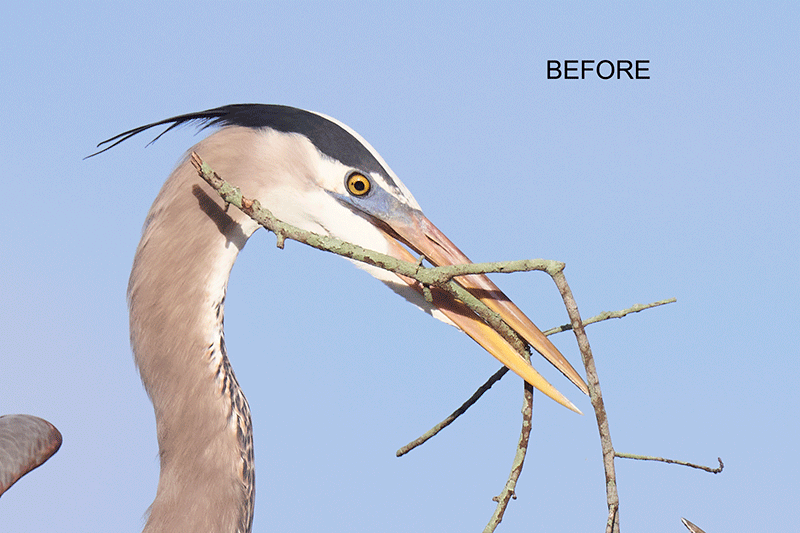
|
The Stick and the Shadow on the Bird’s Face …
I hate the stick and its shadow covering most of the bird’s face so I decided to give the bird a shorter stick … I used the Magnetic Lasso Tool to select the broken end of the stick and put it on its own layer. Then I moved that layer to the middle of the image, clicked off the eyeball for that layer, and activated the layer below. Then I used Divide and Conquer with the Clone Stamp Tool and then used the Patch Tool, Content-Aware Fill, and several small Quick Masks refined, re-shaped, and warped with the addition of a Regular Layer mask and the Transform command. Once the face was cleaned up I clicked on the eyeball for the end of the stick layer, moved it into place with the Move Tool (V), and refined that layer as noted above. Voila!
You can learn the advanced Quick Masking and advanced Layer Masking techniques that I used for the above repair in APTATS I & II. You can save $15 by purchasing the pair.
|
|
The BIRDS AS ART Current Workflow e-Guide (Digital Basics II).You can order your copy from the BAA Online Store here, by sending a PayPal for $40 here, or by calling Jim or Jennifer weekdays at 863-692-0906 with your credit card in hand. Be sure to specify Digital Basics II. |
The BIRDS AS ART Current Workflow e-Guide (Digital Basics II)
The techniques mentioned above and tons more (with the exception of Capture One RAW Conversions) — along with all of my personalized Keyboard Shortcuts — are covered in detail in the BIRDS AS ART Current Workflow e-Guide (Digital Basics II), an instructional PDF that is sent via e-mail. Learn more and check out the free excerpt in the blog post here. While the new e-Guide reflects my MacBook Pro/Photo Mechanic/DPP 4/Photoshop workflow, folks using a PC and/or BreezeBrowser will also benefit greatly by studying the material on DB II. Note: folks working on a PC and/or those who do not want to miss anything Photoshop may wish to purchase the original Digital Basics along with DB II while saving $15 by clicking here to buy the DB Bundle.
Folks who learn well by following along rather than by reading can check out the complete collection of MP 4 Photoshop Tutorial Videos by clicking here. Note: all of the videos are now priced at an amazingly low $5.00 each.
You can learn how and why I converted all of my Canon digital RAW files in DPP 4 in the DPP 4 RAW Conversion Guide here. More recently, I became proficient at converting my Nikon RAW (NEF) files in Adobe Camera Raw. About two years ago I began converting my Nikon and Sony RAW files in Capture One Pro 12 and continue to do so today.
To purchase Capture One, please use this link. Then you can learn more about Capture One in the Capture One Pro 12 Simplified MP4 Video here. The next step would be to get a copy of Arash Hazeghi’s “The Nikon Photographers’ Guide to Phase One Capture One Pro e-Guide” in the blog post here.
You can learn advanced Quick Masking and advanced Layer Masking techniques in APTATS I & II. You can save $15 by purchasing the pair. Folks can learn sophisticated sharpening and (NeatImage) Noise Reduction techniques in The Professional Post Processing Guide by Arash Hazeghi and edited by yours truly. Please use this link to purchase NeatImage.
To introduce folks to our MP.4 videos and the basics involved in applying more NeatImage noise reduction to the background and less on the subject, I’d be glad to send you a free copy of the Free Noise Reduction Basics MP.4 Video. Simply click to shoot me an e-mail to get your free copy.
Typos
In all blog posts and Bulletins, feel free to e-mail or to leave a comment regarding any typos or errors. Just be right :).

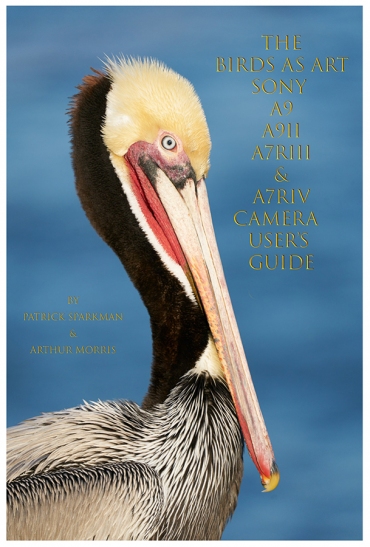

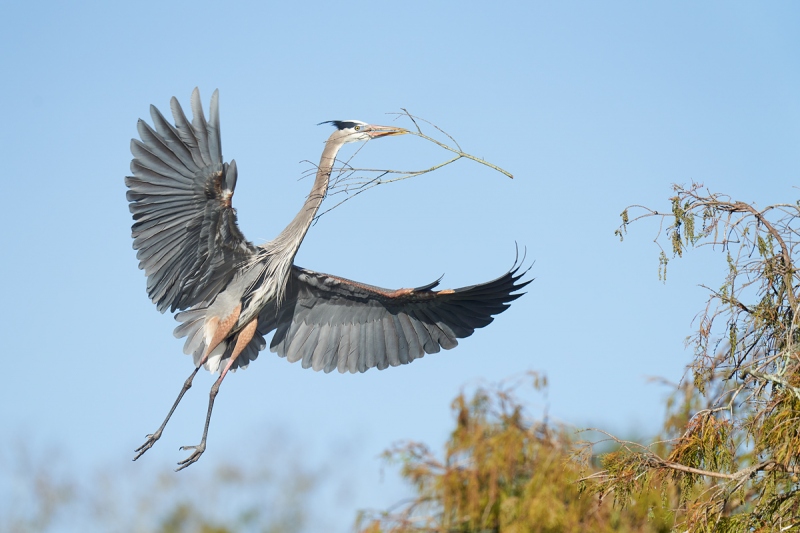
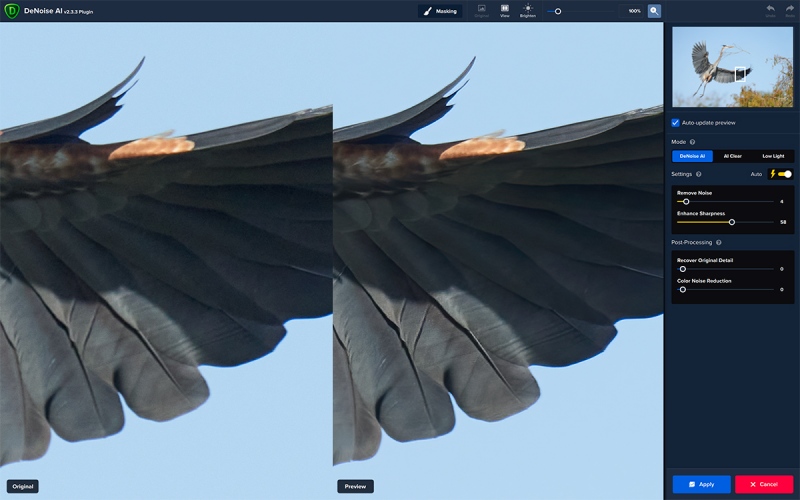
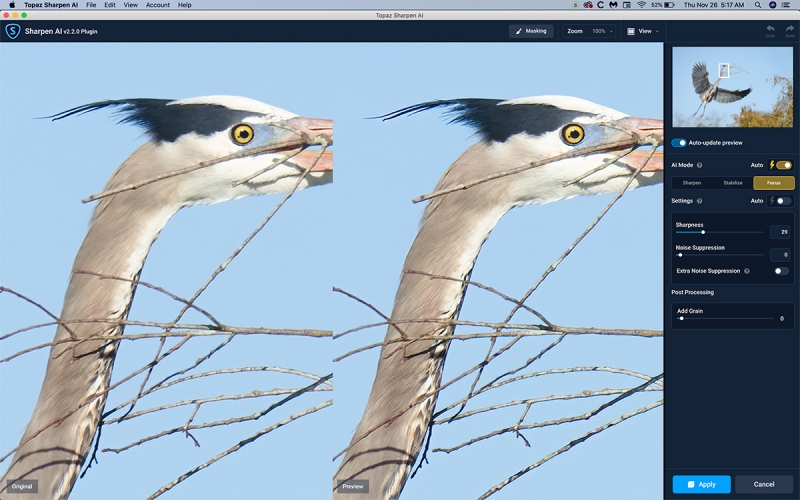
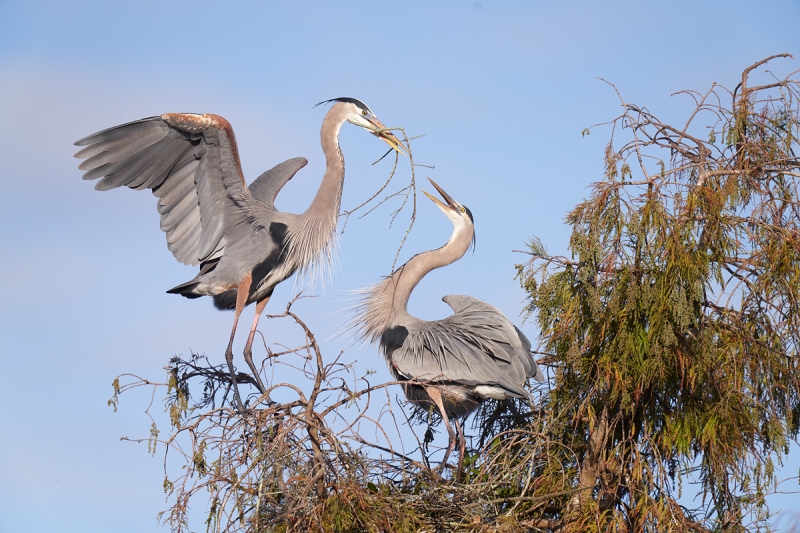
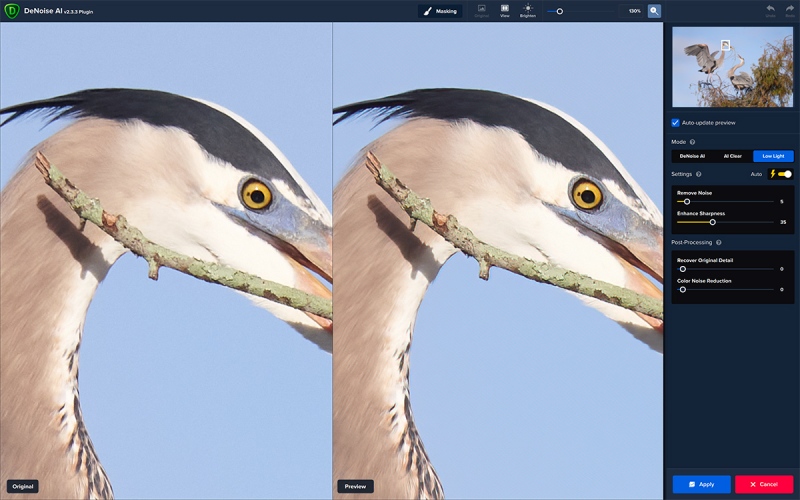














Good morning Guru. Hope you’re doing fine.
Compared to Sony FE 200-600mm, the Canon RF 100-500mm is shorter, slower and pricier. May be good however; no chance to beat the Sony version. Sony is the market leader in MILCs, Canon woke up much later. Moreover, Canon has a tendency to follow their own instincts and passion, not that of the photographers. I wish them well but problem is; they don’t listen.
Best regards.
Am thanks and ditto. The problem is none of the camera manufacturers listen (at least most of the time …)
a
Topaz has Black Friday deal now. I already own denoise and sharpen, so once I signed into my account, the price was adjusted for what I already own and I was able to pick all other remaining apps for 127 after artie’s discount. Too nice!
Thank you kind sir.
with love, a
Congrats on trying out the R5 as that is the system I am currently shooting. Make sure you have the latest lens and body firmware as there were some issues in the initial release. I use BBAF and have programmed the different buttons for a variety of tasks and you should figure out how best to toggle Face+AED on/off. The later doesn’t tend to work well for distant BIF acquisition and I use large horizontal zone to prompt the af on target and hit AED as the subject nears (I have one button as Face+AED and another as large horizontal zone, though one can easily program the back buttons to toggle AED on/off). Overall, the AF is pretty good and extremely accurate, though I found the a9(ii) to be faster in initial focus in some circumstances.
I think you’ll be surprised by the effectiveness of the IBIS for hand holding particularly of static subjects and one can use lower Tv than with the a7riv for flight shots. Images out of camera will appear a bit softer than from the Sony which I attribute to the AA filter, though they handle NR and sharpening very well. I’m still using all of my EF glass very effectively and with very successful results.
There are inherent pluses and minuses with the respective systems though both are capable platforms. Can’t wait to hear your reflections.
Thanks, Adam. I have lots to say already …
with love, artie
Wait till next year, and switch to the Canon R1 and some faster glass! However, I do love the R5 and the RF100-500 lens.
I used the R5 mostly with the 1.4X TC (until the battery ran out) and was quite impressed. There are pluses and minuses when comparing it to the SONY 200-600 and the a9 II. Stay tuned. My percentages have changed …
with love to you and the turtle guy. Are the Ospreys still living at Sebastian?
a